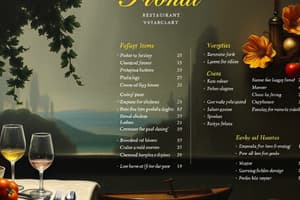Podcast
Questions and Answers
Match the following terms with their descriptions:
Match the following terms with their descriptions:
Clear broth = Type of soup with a transparent liquid base Bruschetta = Small plate appetizer typically featuring toasted bread topped with tomatoes and herbs Roasting = Cooking method often used for meats like beef or chicken Steamed green beans = Type of vegetable side dish prepared by cooking in steam
Match the following menu items with their category:
Match the following menu items with their category:
Hummus = Starter or appetizer Pork = Meat commonly found on menus Mashed potatoes = Grain-based side dish Coleslaw = Vegetable side dish
Match the following terms with their common usage on menus:
Match the following terms with their common usage on menus:
Main course = Central dish of a meal often featuring a protein source Hot and sour soup = Soup characterized by its temperature and flavor profile Side dishes = Components of a meal meant to accompany the main course Chicken = Commonly found meat option on menus
Match the following descriptions with their corresponding terms:
Match the following descriptions with their corresponding terms:
Match the following terms with their role in a meal:
Match the following terms with their role in a meal:
Match the following terms with their characteristics:
Match the following terms with their characteristics:
Flashcards are hidden until you start studying
Study Notes
Understanding Restaurant Vocabulary: Menu Items
Understanding restaurant vocabulary is crucial for anyone looking to enhance their dining experiences. Knowledge of menu items is especially important, as it allows you to navigate a menu with confidence and make informed decisions about what you order. In this article, we will explore various types of menu items and the vocabulary associated with them.
Starters
Starters, also known as hors d'oeuvres or appetizers, are typically served first and intended to whet your appetite before the main course. Examples include soups, salads, or small plates of appetizers such as bruschetta, hummus, or olives.
Soup
Common soup terms include 'clear broth', 'creamy', 'cold', and 'hot'. For instance, 'creamy tomato soup' or 'hot and sour soup' refers to the texture and temperature of the soup.
Main Courses
The main course is the central dish of a meal, often consisting of a protein source like meat, chicken, or fish, accompanied by sides such as vegetables, potatoes, or grains.
Meats
Meats commonly found on menus include beef, chicken, lamb, pork, and turkey. These may be prepared in various ways, such as roasting, grilling, or frying.
Vegetables
Vegetable side dishes may include steamed or sautéed green beans, roasted root vegetables, or coleslaw.
Grains
Common grain-based side dishes include rice, mashed potatoes, and pasta.
Sides
Side dishes are secondary components of a meal, designed to accompany the main course. They may include bread rolls, sauces, or additional vegetables.
Desserts
Desserts typically follow the main course and offer a sweet conclusion to the meal. Options range from cakes and puddings to ice cream and sorbet.
Ice Cream
When ordering ice cream, you might encounter flavors like vanilla, chocolate, strawberry, or mint. Descriptions like 'double scoop' or 'cone' indicate portion sizes.
Allergy Considerations
For customers with allergies or dietary restrictions, menus may highlight allergen-friendly options. Common allergens include wheat, peanuts, shellfish, and tree nuts.
By mastering this basic restaurant vocabulary, you'll be well-equipped to peruse a menu and make informed decisions about your dining choices.
Studying That Suits You
Use AI to generate personalized quizzes and flashcards to suit your learning preferences.




